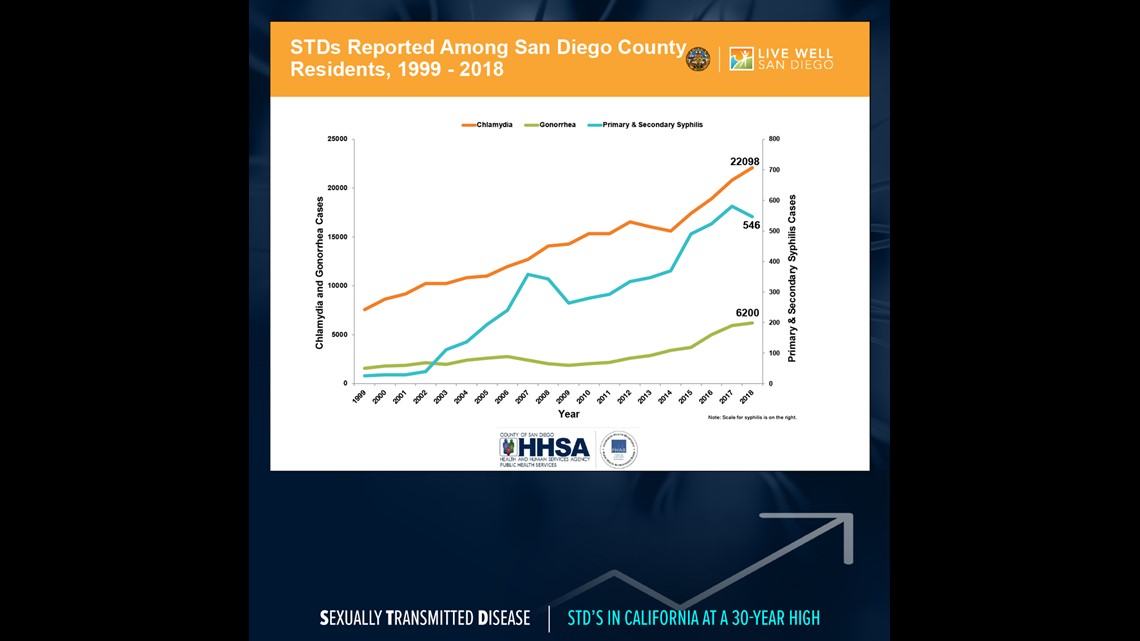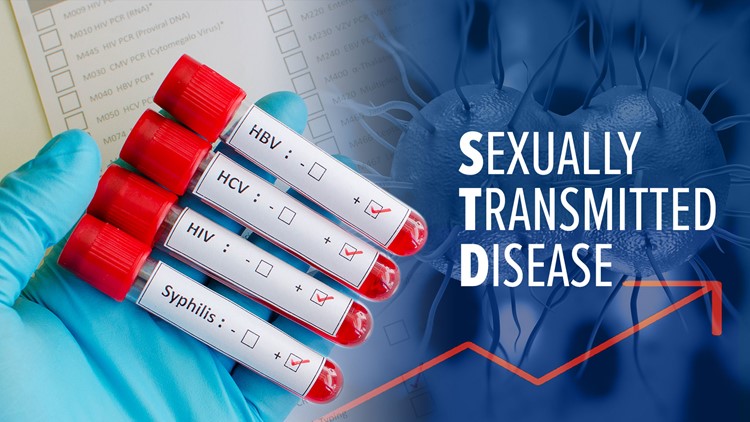SAN DIEGO —
Sexually transmitted diseases are making their way through San Diego County in record numbers, hitting a 20-year high according to a report released by the County of San Diego Health and Human Services Agency on Oct. 4.
“The overall burden of STDs on San Diego County residents remains the highest that it has been for the past two decades,” the county wrote in the report. The report added that STD’s are disproportionately impacting young people and people of color in the county.
It’s not just a San Diego health problem. According to a new report released on Oct. 10, California just hit a statewide 30-year high, calling it an “epidemic.” The new report comes from the California Department of Public Health. The agency says that STDs are increasing in both men and women in counties all over the state, particularly in people ages 15-24.


“Reported cases and rates of STDs have been increasing for over a decade, so unfortunately I was not particularly surprised by any of the data,” said Dr. Winston Tilghman, the Medical Director of the HIV, STD and Hepatitis branch of San Diego Public Health Services.
Tilghman says the rising numbers are likely due to multiple factors, including trends in condom usage.
“It is likely a combination of more testing, better tests (especially for chlamydia and gonorrhea) and increasing transmission of STDs in the community,” said Tilghman.
RELATED: STD cases up in San Diego
Tilghman says there are also a handful of reasons why STDs are on the rise with young people and people of color, such as concerns about confidentiality when discussing STDs with healthcare providers.
“We see the highest STD rates among African-Americans, although STD rates are higher among Hispanic/Latinx persons than among white persons,” said Tilghman. “Less access to healthcare, less education about STD prevention, stigma, discrimination and poverty likely contribute to these disparities.”
Syphilis
The San Diego County report said that reported syphilis cases went down for the first time in four years. However, the California statewide report wrote, “syphilis is a major public health problem in California and has increased in all regions of the state, and among both males and females.” In 2018, 15% of the women ages 15-49 diagnosed with syphilis were pregnant. This is called congenital syphilis, and data shows it’s increased 391% over the last decade in California. Only 15 of those reported cases were in San Diego County in 2018.
According to the California Department of Public Health, “congenital syphilis can cause severe illness in babies including premature birth, low birth weight, birth defects, blindness and hearing loss. It can also lead to stillbirth and infant death.”


It’s a concerning statistic that sticks out to healthcare providers.
“What I find the most alarming is the significant increases of congenital syphilis and fetal and neonatal deaths due to syphilis,” said Tilghman. “While this is not as big of a problem in San Diego County as it is in other parts of California and the U.S., one case of congenital syphilis is one too many, and there were five stillbirths due to syphilis in San Diego County from 2014-2018.”
Tilghman recommends pregnant women seek prenatal care and get tested for syphilis, including during their third trimester.


Chlamydia and gonorrhea
Chlamydia and gonorrhea take the title for the most commonly reported STDs in the Golden State. According to the San Diego HHSA, Chlamydia is the most commonly reported disease in San Diego County and in California. While both of these STDs are curable, they often don’t have symptoms, so people pass them on without even realizing they’re infected or infecting someone else. For that reason, public health officials recommend getting tested for sexually transmitted diseases often and discussing STD’s with your partner before any clothes come off.
In San Diego county, reported cases of gonorrhea increased by 4.3% from 5,947 cases in 2017 to 6,200 cases in 2018. According to the report, the highest rates of infection were observed among men aged 25 to 29 years countywide.
Tilghman says these numbers may be in part because sometimes, young women are more likely to go to the doctor than young men are.
In San Diego County, reported cases of chlamydia increased by 6.2% from 20,801 cases in 2017 to 22,098 cases in 2018. The highest rates of infection countywide were observed among women aged 20 to 24 years. Half of all chlamydia cases reported in California in 2018 were from patients from ages 15-24.
“Young women are more biologically susceptible to STDs than young men[are] which is likely part of the reason why the highest rates of chlamydia are observed among young women,” said Tilghman. “There also is a recommendation for regular screening for chlamydia and gonorrhea in women aged 24 years and younger, which may also explain why there are so many reported cases in this age group.”
Data from both reports show that these sexually transmitted diseases are impacting communities of color disproportionately, and that’s no different with the unwanted gifts that are chlamydia and gonorrhea. Compared to their white counterparts, the rates of reportable STDs among black people in California are nearly five times higher for chlamydia and gonorrhea.
“In order to increase access to chlamydia and gonorrhea testing to young women of color, the County of San Diego operates a home-testing program through which women can do a vaginal swab test by mail,” said Tilghman.
HIV
Some of the data brings hope. Tilghman is optimistic about the advances in HIV treatment.
In 2016, the County of San Diego Board of Supervisors adopted the Getting to Zero initiative, which seeks to eliminate all new HIV infections in San Diego County within 10 years.
“The Getting to Zero initiative is supported by a well-developed HIV service delivery system that can ensure all persons living with HIV in San Diego County can access high quality care, regardless of their insurance status or their ability to pay,” said Tilghman.
In 2018, the number of new reported cases of HIV was 369, which was down by 26% from 2016, when 499 new cases were reported. According to Tilghman, it also is the lowest number of new cases in the county since 1984.
“These advances have made eliminating the HIV epidemic a real possibility,” said Tilghman.
Where to get tested and find free help
These reports, if anything, are eye-opening.
“We can learn that STDs are common, that they may not always cause symptoms and that they can be serious,” said Tilghman.
While the numbers in the reports may seem overwhelming, getting tested regularly for STDs can make all the difference. Tilghman recommends getting tested at least once per year, or perhaps every three to six months if you have multiple sexual partners.
“If there is ever any doubt, it is better to just get tested,” said Tilghman.
The County of San Diego has STD clinics in four different locations that offer both STD testing and treatment. The clinics charge a $40 fee that is waived for those who cannot pay. Clinic locations and hours of operation are available here.
There are also plenty of places to find free condoms. Condoms and information are available for free at all County of San Diego STD clinics. CondomFinder is an online resource that can help you find free condoms and the Condom Access Project offers free condoms and other resources for young people to protect themselves against STDs.
For more information on STD treatment and prevention, click here.
You can read the California statewide report here:



